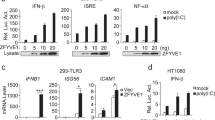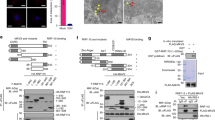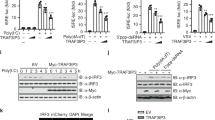Abstract
MITA is a central adaptor in innate immune responses to DNA viruses. The mechanisms responsible for recruitment of downstream kinase TBK1 and the transcription factor IRF3 to MITA remains enigmatic. Here we identified ZDHHC11, a member of DHHC palmitoyl transferase family, as a positive regulator of DNA virus-triggered signaling. Overexpression of ZDHHC11 activated the IFN-β promoter, while ZDHHC11-deficiency specifically impaired DNA virus HSV-1-induced transcription of downstream antiviral genes. Zdhhc11 −/− mice exhibited lower serum cytokine levels and higher lethality after HSV-1 infection. Mechanistically, ZDHHC11 facilitated the optimal recruitment of IRF3 to MITA. Our findings support an important role for ZDHHC11 in mediating MITA-dependent innate immune responses against DNA viruses.
This is a preview of subscription content, access via your institution
Access options
Subscribe to this journal
Receive 12 digital issues and online access to articles
$119.00 per year
only $9.92 per issue
Buy this article
- Purchase on Springer Link
- Instant access to full article PDF
Prices may be subject to local taxes which are calculated during checkout






Similar content being viewed by others

References
Akira S. TLR signaling. Curr Top Microbiol Immunol 2006; 311: 1–16.
Medzhitov R, Janeway CA Jr.. Innate immunity: the virtues of a nonclonal system of recognition. Cell 1997; 91: 295–298.
Li XD, Wu J, Gao D, Wang H, Sun L, Chen ZJ. Pivotal roles of cGAS-cGAMP signaling in antiviral defense and immune adjuvant effects. Science 2013; 341: 1390–1394.
Sun L, Wu J, Du F, Chen X, Chen ZJ. Cyclic GMP-AMP synthase is a cytosolic DNA sensor that activates the type I interferon pathway. Science 2012; 339: 786–791.
Zhang X, Shi H, Wu J, Zhang X, Sun L, Chen C et al. Cyclic GMP-AMP containing mixed phosphodiester linkages is an endogenous high-affinity ligand for STING. Mol Cell 2013; 51: 226–235.
Wu J, Sun L, Chen X, Du F, Shi H, Chen C et al. Cyclic GMP-AMP is an endogenous second messenger in innate immune signaling by cytosolic DNA. Science 2013; 339: 826–830.
Burdette DL, Vance RE. STING and the innate immune response to nucleic acids in the cytosol. Nat Immunol 2013; 14: 19–26.
Abe T, Harashima A, Xia T, Konno H, Konno K, Morales A et al. STING recognition of cytoplasmic DNA instigates cellular defense. Mol Cell 2013; 50: 5–15.
Ishikawa H, Barber GN. STING is an endoplasmic reticulum adaptor that facilitates innate immune signalling. Nature 2008; 455: 674–678.
Ouyang S, Song X, Wang Y, Ru H, Shaw N, Jiang Y et al. Structural analysis of the STING adaptor protein reveals a hydrophobic dimer interface and mode of cyclic di-GMP binding. Immunity 2012; 36: 1073–1086.
Shu C, Yi G, Watts T, Kao CC, Li P. Structure of STING bound to cyclic di-GMP reveals the mechanism of cyclic dinucleotide recognition by the immune system. Nat Struct Mol Biol 2012; 19: 722–724.
Zhong B, Yang Y, Li S, Wang YY, Li Y, Diao F et al. The adaptor protein MITA links virus-sensing receptors to IRF3 transcription factor activation. Immunity 2008; 29: 538–550.
Liu S, Cai X, Wu J, Cong Q, Chen X, Li T et al. Phosphorylation of innate immune adaptor proteins MAVS, STING, and TRIF induces IRF3 activation. Science 2015; 347: aaa2630.
Zhou Q, Lin H, Wang S, Wang S, Ran Y, Liu Y et al. The ER-associated protein ZDHHC1 is a positive regulator of DNA virus-triggered, MITA/STING-dependent innate immune signaling. Cell Host Microbe 2014; 16: 450–461.
Li Y, Chen R, Zhou Q, Xu Z, Li C, Wang S et al. LSm14A is a processing body-associated sensor of viral nucleic acids that initiates cellular antiviral response in the early phase of viral infection. Proc Natl Acad Sci USA 2012; 109: 11770–11775.
Xu LG, Wang YY, Han KJ, Li LY, Zhai Z, Shu HB. VISA is an adapter protein required for virus-triggered IFN-beta signaling. Mol Cell 2005; 19: 727–740.
Liu TT, Yang Q, Li M, Zhong B, Ran Y, Liu LL et al. LSm14A plays a critical role in antiviral immune responses by regulating MITA level in a cell-specific manner. J Immunol 2016; 194: 5101–5111.
Jiang LQ, Xia T, Hu YH, Sun MS, Yan S, Lei CQ et al. IFITM3 inhibits virus-triggered induction of type I interferon by mediating autophagosome-dependent degradation of IRF3. Cell Mol Immunol 2017 doi:10.1038/cmi.2017.15.
Yang Q, Liu TT, Lin H, Zhang M, Wei J, Luo WW et al. TRIM32-TAX1BP1-dependent selective autophagic degradation of TRIF negatively regulates TLR3/4-mediated innate immune responses. PLoS Pathog 2017; 13: e1006600.
Hu MM, Yang Q, Zhang J, Liu SM, Zhang Y, Lin H et al. TRIM38 inhibits TNFalpha- and IL-1beta-triggered NF-kappaB activation by mediating lysosome-dependent degradation of TAB2/3. Proc Natl Acad Sci USA 2014; 111: 1509–1514.
Hu MM, Xie XQ, Yang Q, Liao CY, Ye W, Lin H et al. TRIM38 Negatively Regulates TLR3/4-Mediated Innate Immune and Inflammatory Responses by Two Sequential and Distinct Mechanisms. J Immunol 2015; 195: 4415–4425.
Luo WW, Li S, Li C, Lian H, Yang Q, Zhong B et al. iRhom2 is essential for innate immunity to DNA viruses by mediating trafficking and stability of the adaptor STING. Nat Immunol 2016; 17: 1057–1066.
Mukai K, Konno H, Akiba T, Uemura T, Waguri S, Kobayashi T et al. Activation of STING requires palmitoylation at the Golgi. Nat Commun 2016; 7: 11932.
Gao D, Wu J, Wu YT, Du F, Aroh C, Yan N et al. Cyclic GMP-AMP synthase is an innate immune sensor of HIV and other retroviruses. Science 2013; 341: 903–906.
Tanaka Y, Chen ZJ. STING specifies IRF3 phosphorylation by TBK1 in the cytosolic DNA signaling pathway. Sci Signal 2012; 5: ra20.
Hu MM, Shu HB. Multifaceted roles of TRIM38 in innate immune and inflammatory responses. Cell Mol Immunol 2017; 14: 331–338.
Luo WW, Lian H, Zhong B, Shu HB, Li S. Kruppel-like factor 4 negatively regulates cellular antiviral immune response. Cell Mol Immunol 13: 65–72.
Hu MM, Yang Q, Xie XQ, Liao CY, Lin H, Liu TT et al. Sumoylation Promotes the Stability of the DNA Sensor cGAS and the Adaptor STING to Regulate the Kinetics of Response to DNA Virus. Immunity 2016; 45: 555–569.
Luo WW, Li S, Li C, Lian H, Yang Q, Zhong B et al. iRhom2 is essential for innate immunity to DNA viruses by mediating trafficking and stability of the adaptor STING. Nat Immunol 2016; 17: 1057–1066.
Wang Q, Liu X, Cui Y, Tang Y, Chen W, Li S et al. The E3 ubiquitin ligase AMFR and INSIG1 bridge the activation of TBK1 kinase by modifying the adaptor STING. Immunity 2014; 41: 919–933.
Xia P, Ye B, Wang S, Zhu X, Du Y, Xiong Z et al. Glutamylation of the DNA sensor cGAS regulates its binding and synthase activity in antiviral immunity. Nat Immunol 2016; 17: 369–378.
Fang C, Deng L, Keller CA, Fukata M, Fukata Y, Chen G et al. GODZ-mediated palmitoylation of GABA(A) receptors is required for normal assembly and function of GABAergic inhibitory synapses. J Neurosci 2006; 26: 12758–12768.
Korycka J, Lach A, Heger E, Boguslawska DM, Wolny M, Toporkiewicz M et al. Human DHHC proteins: a spotlight on the hidden player of palmitoylation. Eur J Cell Biol 2012; 91: 107–117.
Chen W, Li S, Yu H, Liu X, Huang L, Wang Q et al. ER adaptor SCAP translocates and recruits IRF3 to perinuclear microsome induced by cytosolic microbial DNAs. PLoS Pathog 2016; 12: e1005462.
Acknowledgements
This work was supported by grants from the National Key R&D Program of China (2017YFA0505800, 2016YFA0502102), the National Natural Science Foundation of China (31630045, 31521091, 91429304 and 31671465), the Fundamental Research Funds for the Central Universities (2042017kf0205, 2042017kf0242) and Wuhan University Experiment Technology Project Funding.
Author information
Authors and Affiliations
Corresponding authors
Ethics declarations
Conflict of interest
The authors declare no conflict of interest.
Electronic supplementary material
Rights and permissions
About this article
Cite this article
Liu, Y., Zhou, Q., Zhong, L. et al. ZDHHC11 modulates innate immune response to DNA virus by mediating MITA–IRF3 association. Cell Mol Immunol 15, 907–916 (2018). https://doi.org/10.1038/cmi.2017.146
Received:
Revised:
Accepted:
Published:
Issue Date:
DOI: https://doi.org/10.1038/cmi.2017.146
Keywords
This article is cited by
-
Protein lipidation in cancer: mechanisms, dysregulation and emerging drug targets
Nature Reviews Cancer (2024)
-
Protein lipidation in health and disease: molecular basis, physiological function and pathological implication
Signal Transduction and Targeted Therapy (2024)
-
Mitochondrial DNA-triggered innate immune response: mechanisms and diseases
Cellular & Molecular Immunology (2023)
-
SNX8 modulates the innate immune response to RNA viruses by regulating the aggregation of VISA
Cellular & Molecular Immunology (2020)
-
The zinc-finger protein ZFYVE1 modulates TLR3-mediated signaling by facilitating TLR3 ligand binding
Cellular & Molecular Immunology (2020)


